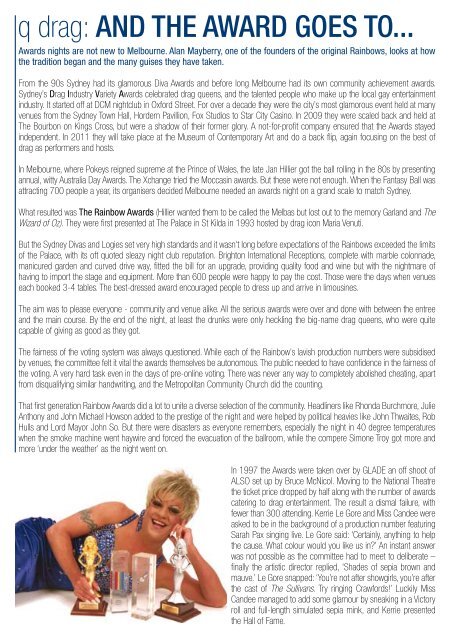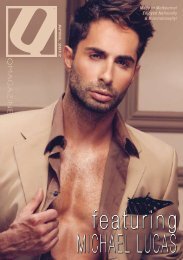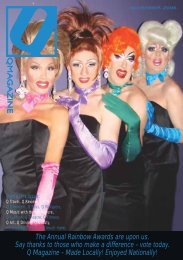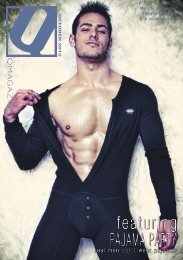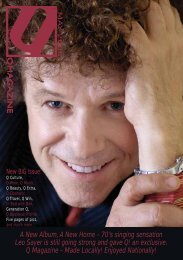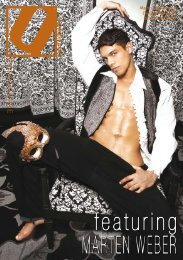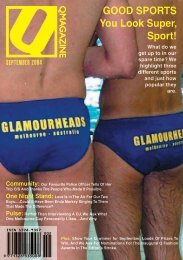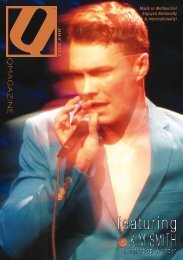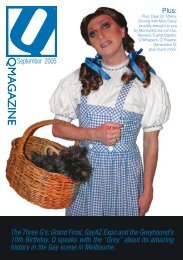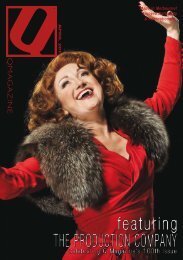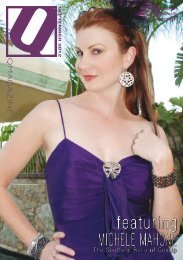August 2010 - Q Magazine
August 2010 - Q Magazine
August 2010 - Q Magazine
Create successful ePaper yourself
Turn your PDF publications into a flip-book with our unique Google optimized e-Paper software.
q drag: AND THE AWARD GOES TO...<br />
Awards nights are not new to Melbourne. Alan Mayberry, one of the founders of the original Rainbows, looks at how<br />
the tradition began and the many guises they have taken.<br />
From the 90s Sydney had its glamorous Diva Awards and before long Melbourne had its own community achievement awards.<br />
Sydney’s Drag Industry Variety Awards celebrated drag queens, and the talented people who make up the local gay entertainment<br />
industry. It started off at DCM nightclub in Oxford Street. For over a decade they were the city’s most glamorous event held at many<br />
venues from the Sydney Town Hall, Hordern Pavillion, Fox Studios to Star City Casino. In 2009 they were scaled back and held at<br />
The Bourbon on Kings Cross, but were a shadow of their former glory. A not-for-profit company ensured that the Awards stayed<br />
independent. In 2011 they will take place at the Museum of Contemporary Art and do a back flip, again focusing on the best of<br />
drag as performers and hosts.<br />
In Melbourne, where Pokeys reigned supreme at the Prince of Wales, the late Jan Hillier got the ball rolling in the 80s by presenting<br />
annual, witty Australia Day Awards. The Xchange tried the Moccasin awards. But these were not enough. When the Fantasy Ball was<br />
attracting 700 people a year, its organisers decided Melbourne needed an awards night on a grand scale to match Sydney.<br />
What resulted was The Rainbow Awards (Hillier wanted them to be called the Melbas but lost out to the memory Garland and The<br />
Wizard of Oz). They were first presented at The Palace in St Kilda in 1993 hosted by drag icon Maria Venuti.<br />
But the Sydney Divas and Logies set very high standards and it wasn't long before expectations of the Rainbows exceeded the limits<br />
of the Palace, with its oft quoted sleazy night club reputation. Brighton International Receptions, complete with marble colonnade,<br />
manicured garden and curved drive way, fitted the bill for an upgrade, providing quality food and wine but with the nightmare of<br />
having to import the stage and equipment. More than 600 people were happy to pay the cost. Those were the days when venues<br />
each booked 3-4 tables. The best-dressed award encouraged people to dress up and arrive in limousines.<br />
The aim was to please everyone - community and venue alike. All the serious awards were over and done with between the entree<br />
and the main course. By the end of the night, at least the drunks were only heckling the big-name drag queens, who were quite<br />
capable of giving as good as they got.<br />
The fairness of the voting system was always questioned. While each of the Rainbow's lavish production numbers were subsidised<br />
by venues, the committee felt it vital the awards themselves be autonomous. The public needed to have confidence in the fairness of<br />
the voting. A very hard task even in the days of pre-online voting. There was never any way to completely abolished cheating, apart<br />
from disqualifying similar handwriting, and the Metropolitan Community Church did the counting.<br />
That first generation Rainbow Awards did a lot to unite a diverse selection of the community. Headliners like Rhonda Burchmore, Julie<br />
Anthony and John Michael Howson added to the prestige of the night and were helped by political heavies like John Thwaites, Rob<br />
Hulls and Lord Mayor John So. But there were disasters as everyone remembers, especially the night in 40 degree temperatures<br />
when the smoke machine went haywire and forced the evacuation of the ballroom, while the compere Simone Troy got more and<br />
more ‘under the weather’ as the night went on.<br />
In 1997 the Awards were taken over by GLADE an off shoot of<br />
ALSO set up by Bruce McNicol. Moving to the National Theatre<br />
the ticket price dropped by half along with the number of awards<br />
catering to drag entertainment. The result a dismal failure, with<br />
fewer than 300 attending. Kerrie Le Gore and Miss Candee were<br />
asked to be in the background of a production number featuring<br />
Sarah Pax singing live. Le Gore said: ‘Certainly, anything to help<br />
the cause. What colour would you like us in?’ An instant answer<br />
was not possible as the committee had to meet to deliberate –<br />
finally the artistic director replied, ‘Shades of sepia brown and<br />
mauve.’ Le Gore snapped: ‘You’re not after showgirls, you’re after<br />
the cast of The Sullivans. Try ringing Crawfords!’ Luckily Miss<br />
Candee managed to add some glamour by sneaking in a Victory<br />
roll and full-length simulated sepia mink, and Kerrie presented<br />
the Hall of Fame.


